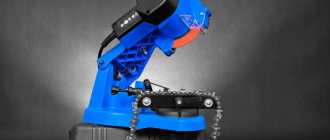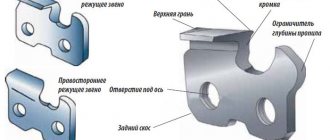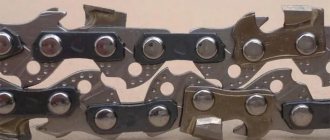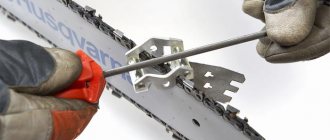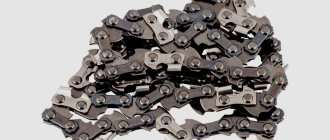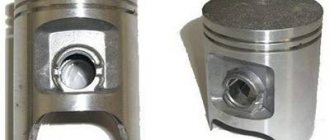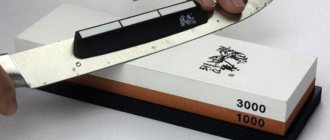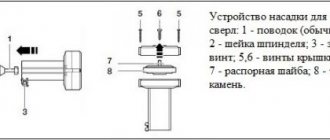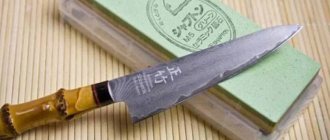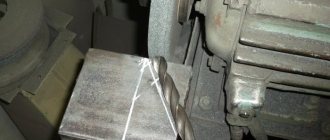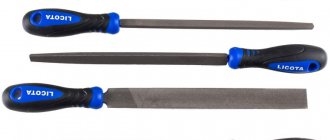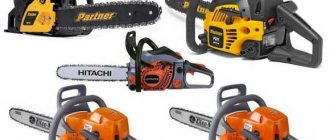When should the work be done?
When using a chainsaw intensively, sharpening is carried out quite often, often several times in one day. Particular attention should be paid to the fact that the contact of the chain with the ground significantly speeds up the process. Therefore, chainsaws must be used in such a way as to eliminate the possibility of contact between the chain and the ground. After several contacts, the chips will be very small, and the chain will go deeper into the material slightly. When considering this issue, it can be noted: the more often you have to sharpen the chainsaw chain, the less metal layer is removed. Also, if you sharpen frequently, the service life of the cutting element of the chainsaw will increase significantly. The main condition can be called the correct execution of the work, if you do it yourself. The procedure can only be performed correctly if you have a special machine. A sign that the cutting element of a hand chainsaw has become dull is a significant feed force. Properly sharpened chains determine a significant reduction in the feed force, that is, the chainsaws enter easily with a little pressure. Another sign of the need to sharpen chains is the production of very small chips. Sharpening a chainsaw when the signs in question appear is mandatory. Sharpening of chains is carried out in order to greatly reduce the tension in the body, reduce the cyclic load rate and fuel consumption. Also, if you do not sharpen the teeth of the chains on time, there is a possibility of increased wear of all components, as a result of which the service life of the hand chainsaw is reduced.
What are the dangers of working with a blunt instrument?
You should not use a dull chainsaw chain.
Working with a faulty tool in itself is fraught with many unpleasant consequences, and here are some of them:
- Reduced efficiency, that is, less work will be completed in the same time.
- The mechanism begins to wear out, and individual parts are also at risk of breaking.
- Excessive fuel consumption.
Geometry Features
In order to sharpen correctly with your own hands, even if you use a machine, you should know the geometry of the tooth. Its constituent elements include:
- Spatula.
- The main link.
- Depth limiter.
In this case, the tooth blade consists of the following elements:
- End blade.
- Top blade.
You need to sharpen correctly with your own hands, taking into account the fact that the end and top blades must be positioned correctly relative to each other to ensure the best cutting performance. The back of the tooth forms a certain angle of the upper blade. A similar angle is formed to cut the blades into the material. Sharpening with your own hands should also take into account the fact that the blade has a narrowing towards the back - this design feature forms the angle of the end blade. It is created to ensure lateral cutting of chips.
Chainsaw chain tooth
The sliding surface and the end part of the blade forms the rake angle. In this case, the angle has a fixed value; it varies from 60 to 85 degrees. If you sharpen the teeth with your own hands, it is worth considering that the upper blade is the main one, and the angle formed by it is the most important angle. To summarize, when considering the issue of geometry features, we note that the sharpening angle can vary depending on the conditions of use. The basic rule that should be followed when sharpening a tooth with your own hands is the following: the higher the angle, the greater the performance of the chainsaw, but reducing the value ensures smoother running of the blades, reduced vibration and increased service life. It is worth sharpening taking into account that the indicator should be in the range from 25 to 35 degrees. An exception is the version of the blade, which is intended for longitudinal cutting - many manufacturers of the chainsaw cutting element can withstand 10 degrees.
Saw design
To better understand what a chainsaw is and how it works, it is advisable to know how it works.
By the way, it would be more correct to call the cutting tool of a chainsaw a saw chain.
The first saw chains appeared at the beginning of the twentieth century. The designers did not begin to puzzle; they simply mounted teeth on the chain, which quickly lost their functionality. In appearance they resembled those that stand on hand hacksaws for wood. Sharpening such a chainsaw caused great difficulties. But repeated attempts to create the perfect saw chain were crowned with success only in 1947.
Chainsaw device
This chainsaw has links with an L-shaped cut. Modern chains are, in fact, the direct ancestors of this development.
If during work the cutting speed begins to decrease, the chainsaw in the hands of the master begins to “walk”, then most likely the saw chain has lost its operational properties, that is, it has become dull and measures must be taken to restore them.
Correct chain tension adjustment
A special tensioning device located in the lower part of the power saw body helps to properly tension the chain on the electric saw. To perform this operation correctly, you first need to correctly attach the cutting element to the saw bar. There is a simple method for putting on a chain correctly.
- Loosen the nuts securing the tire to the body.
- With one hand, lift the bar with the far end up without removing it from the saw.
- With the second hand, the cutting element is put on the driven sprocket of the tire, and the shanks of the guide teeth are inserted into the grooves (“streams”) of the tire.
- The lower part of the cutting element is put on the drive sprocket and the tire is lowered to a horizontal position.
- Lightly pressing the tire to the body with the fastening nuts, they begin to tighten the cutting element, turning the adjusting screw of the tension device with a screwdriver.
- As soon as the cutting element is sufficiently tensioned, the fastening nuts are tightened.
Checking the tension: the operator grabs the upper bowstring with his hand and lifts it to the top. Normal tension is the tension when it rises so that the shanks of the three higher than all raised guide teeth become visible, that is, by 0.5-0.6 cm. If the chain meets this requirement, then the operation is completed. If the tension is incorrect, the fastening nuts are loosened and either additionally tightened or loosened. After adjustment, the nuts are tightened again and the tension is checked again. It is often considered normal tension if the bowstring makes a loud click when released as it hits the tire.
Sharpening the cutting part is not a difficult job, but it also requires knowledge and a little experience. The described technique is the same for chainsaws and electric saws, since they differ only in the type of engine. The basic requirements when sharpening any chain saw are caution, attentiveness and accuracy.
Why does the tool become dull?
Each chainsaw has a certain durability period. This is the time from the start of work with a new tool until it becomes inoperable.
Destruction or wear of a cutting tool intended for woodworking occurs due to the impact of a set of forces arising during the cutting process. One of the key ones is friction force. Dulling of the saw chain occurs due to prolonged work, due to the use of a chainsaw for purposes other than its intended purpose.
The amount of wear can be defined as a measure of weight, measured in milligrams. Wear is a parameter that shows a change in the characteristics of the shape and size of the cutting blade. The change in geometric parameters that occurs during cutting, and there is no linear wear, is called blunting.
There are parameters on the basis of which a decision is made about the possibility of further operation of the tool. In particular, when examining the teeth of a saw chain, it is necessary to pay attention to the edges of the front and rear surfaces, the height of the blade, and the wear area. If they are in unsatisfactory condition, it means it’s time to sharpen the chainsaw.
Signs that the saw has lost its sharpness include the following:
- Reducing chip size.
- Using more force to do the job.
Replacing the saw chain yourself
Companies that produce electric saws do not prohibit replacing the chain yourself; on the contrary, they often include new products with instructions for repairing and replacing individual parts. You should start by purchasing a new chain.
We check the chain for compliance, that is, we study its characteristics: length (depending on the tire), pitch size (relative to the sprockets), thickness of the drive link
One of the common designs of budget saws is with side tension. To change the chain, perform the following steps in turn:
- move the protective shield while releasing the brake;
- use a screwdriver to turn the control tension screw, unscrew the nut, thereby loosening the tension;
- remove the cover;
- separate the bar and chain from the sprocket;
- remove the old chain from the tire and install a new one in its place;
- We perform the steps in reverse order.
We tighten the chain smoothly, without jerking. We finally tighten it after closing the plastic cover using a screw and nut.
There are modern systems for keyless chain tensioning, but many mechanics prefer traditional side tensioning, which is somewhat problematic, but proven and reliable.
Modern models of electric saws have so-called wing nuts for efficient chain tension. Thanks to this element, the replacement process is faster - and this is important for large volumes of work. Having released the brake, unscrew the nut and remove the cover. Slightly moving the tire back, remove the old chain, put on a new one - first on the sprocket, then along the entire length. Then we put the sprocket in place and tighten the nut. We turn the tension wheel in the direction indicated on the body and finally tighten the “lamb”.
The last step is to check the chain tension. It should fit snugly against the tire when the brake is released, but rotate under manual pressure. For a more effective check, it is recommended to run the saw at low speeds
You can watch the video for more information about chain tensioning:
Recent Entries
Lilac perennials that are beautiful, compact and do not crowd out other plants Why when buying seedlings you should not take the sellers’ word for it and how to determine the age of the plant using 3 signs Tomato seedlings have turned purple or whitish: why the color has changed and how to save the plants
When to sharpen and how to find out about it
After examining the saw chain, the master decides whether it is time to sharpen the tool or not.
As a rule, the saw chain loses its performance properties during intensive work. It can get to the point where the chain will have to be sharpened several times in one day. The cause may also be contact of the saw with the ground. In fact, just scrape the saw chain across the ground a few times and you can stop all work. The chainsaw will simply stop going into the tree. By the way, one of the signs of a dull saw is the appearance of small chips.
Dull chainsaw chain
The sooner measures are taken to sharpen the chain, the longer it will last. It is quite easy to understand when resharpening is required. There will be a feed change. A chain with properly sharpened teeth will retract even with a small force, but if during operation you have to exert a greater feeding force, then this means only one thing, the teeth have lost their sharpness.
Do not use a blunt chain. By the way, this is a safety requirement. And the process will require significant muscular effort from the lumberjack. As a result, this leads to a decrease in cut quality, an increase in the amount of fuel used and accelerated chain wear.
How can you tell if a chain is dull?
There are several signs by which you can understand that the chain is currently not suitable for operation:
- You need to put in more physical effort for the same action.
- Chain stretching.
- Feeling of vibration when working with a tool.
- The unevenness of sawdust, which, moreover, becomes more like dust.
Expert opinion
Kuznetsov Vasily Stepanovich
According to many experts, a well-sharpened chain is more important than engine power.
The chain can also become dull for several reasons:
- Mishandling.
- Contact with objects that are too hard, such as stones.
- Too voluminous and long-term work.
File
A file can be used to carry out the work in question. A file is used to remove the required layer of metal from the surface. A special set was created for this case:
- The file is round and has an unusual holder.
- Flat file needed to adjust the depth limit.
- Hook.
- Special template.
The round file holder is created along with marking lines that are used to position the tool correctly. During operation, the plate itself comes into contact with the depth stop and the surface of the blades, and the file moves around and removes a layer of metal. The use of a special holder with a file allows you to ensure the correct fit of the tools to the surface being processed. You should only use a file that is designed to perform such work.
Angles of inclination when sharpening with a file
The rules of work include:
- The same number of movements should be done.
- It is necessary to control the force of pressure on the surface during processing.
- The template, which is used together with the file, allows you to maintain important sharpening parameters.
With different lengths, uneven travel and the formation of cracks in the material are observed. If the length indicator is not the same at the start of processing, then all cutting teeth are filed according to the indicator of the smallest one.
Application of special machines
It is not always possible to use a hand tool with a template. For example, if the cutting edge comes into contact with the ground during operation, there is a possibility of its deformation. In this situation, a special machine is used. The machine comes in two types:
- Mechanical.
- Electric.
The power saw has a design that looks like a bow saw, but with a round file. The machine can be used to level the length of all edges and restore the correct geometry. The machine in question has a complex system for setting processing parameters. Sharpening is performed in approximately 2-3 movements, after which the machine is installed in a new location.
The electric machine is easy to use. A special adjustment system allows you to correctly position the surface to be treated, as well as position the disc with high accuracy. Some models have an automatic vice clamping system when the disk is lowered. The cost of the electric version is slightly higher, but at the same time the performance increases significantly and the most accurate result can be achieved.
PDF Guide to Sharpening Stihl Saw Chains
How to properly sharpen a chainsaw chain with your own hands. Step-by-step instruction
Bringing a chain into working condition has its own characteristics. They are determined by the configuration of the tooth. It includes two edges, located - one at the top and the other at the bottom. Moreover, the edge located towards the top has a slope at a given angle. In fact, the tooth, both in geometry and in its operating principle, is similar to the blade of a carpenter’s plane.
Manual chain sharpening diagram
For competent sharpening, the master must understand the structure of the tooth.
Teeth parameters
The tooth structure consists of:
- grounds;
- shoulder blades;
- limiter.
Two cutting edges are formed on the blade, one is placed on a horizontal plane, the other at an angle. To obtain the required parameters, the blades are sharpened at the angle specified in the technical specifications. The rake angle is sharpened in the range from 60 to 85 °.
The clearance angle indicates the backward tilt of the upper blade. It lies in the range of 50 to 60°. The blade located on top is considered the main one; the rear angle in this design is very important. It is difficult to measure; if the sharpening rules are followed and the geometric parameters are observed, it is formed in the specified range.
Teeth
The corners are sharpened depending on the use of the tool. The main rule is that the larger the angle, the greater the efficiency when processing soft wood; the smaller the angle, the easier it is to operate the saw with hard wood. That is, the smoothness of operation improves and the vibration of the tool decreases.
Meanwhile, the situation of sharpening the angle greater than 35 and less than 25° should be avoided. This rule does not apply to rip chains.
The angles change when editing the tool. They have an important impact on cutting parameters, so all technical requirements must be carefully followed.
How to determine the tooth angle?
When buying a chainsaw, you need to purchase a special template that allows you to check and sharpen the teeth of the saw chain at the required angle. Templates are sold separately and are supplied with the chainsaw. It can be used to control the values of the back angles at the top and end blades, as well as the leading edge of the tooth edge. AliExpress
Figure 2
Visually determining and correcting the angle is highly not recommended, since different sharpening of the teeth will lead to rapid wear of the chain and saw mechanisms.
It is very important to determine the rear angle of the upper blade using a template, since the range of this angle varies from 50° to 60°, and any deviation can lead to increased wear.
In order to measure the sharpening angle, you must perform the following steps:
- Set perpendicular to the chain surface or the flat surface of the tooth edge.
- Align the template in relation to the tooth.
- Place a round file into the template and check the closure.
- If there are deviations of the tooth from the template, it means the angle does not correspond to the sharpening parameters and needs to be straightened.
Determining the angle using measuring instruments is impractical, since measurement methods without a template have a high error, which will affect the quality of the cut and the performance characteristics of the chainsaw.
Tips and tricks on how to sharpen a chainsaw at home
It is permissible to use a file for sharpening, but you must understand that such operation of the saw will require certain skills and, of course, patience from the master. To sharpen each tooth, you need to have flat and round needle files on hand. To sharpen a tooth, without using additional equipment, it is necessary to maintain the basic sharpening inclination. Only 2-3 passes with a file are enough for sharpening, so there is no point in inventing some kind of equipment to fix the tooth in a certain position. To sharpen the top edge, the file must be held at the required angle while working. Restoring operability begins with preparation, namely, from the working edges; it is necessary to remove all nicks.
If everything is clear with the angles of the teeth with straight parts of the structure, then the edge located on the side and its working inclination cause certain difficulties. To straighten them, you need to use a round file or a small file. These tooth elements are sharpened at the required angle.
Sharpening a chain with a grinder
The process is quite fast, but it is worth remembering precautions: one wrong move can completely ruin the chain or the entire bar.
In addition, the chainsaw must be securely fastened so as not to jump off and injure the owner.
The stages of sharpening with a grinder include:
- Securing the chain to the bar.
- Installation of a disc up to 2 mm thick on a grinder. Craftsmen recommend taking an old disk with an already marked edge.
- Installing a barrier between the bar and the chain (you can put a sliver).
- Sharpen the chain teeth on both sides at an angle of 30 degrees. There is no need to put excessive pressure on the tooth. It is important not to overheat the metal or cut off too much.
- Pull the chain.
Sharpening on a machine
If sharpening work is carried out quite often, then it is necessary to use special equipment and technological equipment (templates). Using a template on a device of this type allows you to complete this work much faster. Such a device can be a wooden block of small size. This type of template should allow sharpening at two angles. Sharpening can be done using a small diameter grinding wheel or an emery belt that can be mounted in place of the belt drive.
Chainsaw chain sharpening machine
Sharpening a chainsaw chain with a machine
Machines of this type, masters, can be made independently, using the drive from a foot-operated sewing machine as the basis for the design. Using a belt drive and a template, it is possible to process one cutting edge and then another.
Technical features of the sharpening process
The sharpening operation is complicated by the fact that the teeth have a large number of cutting edges located in different planes and having different sharpening angles. When sharpening teeth, it is necessary to make the same amount of movement, and it is necessary to withstand the same pressure force. As a result, all teeth will receive the same type of sharpening.
Also, if the saw chain is sharpened more than 4 or 5 times, then the depth stop must be reduced.
